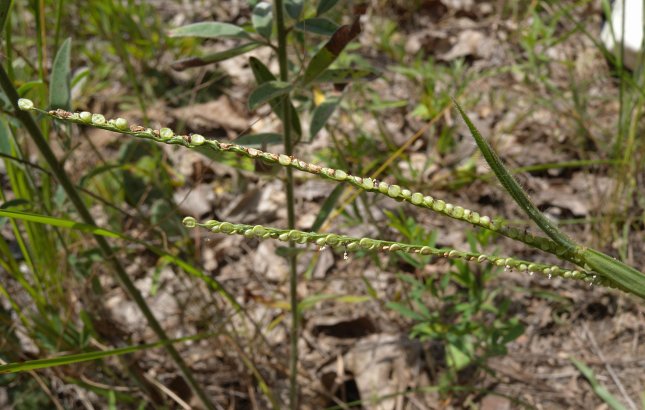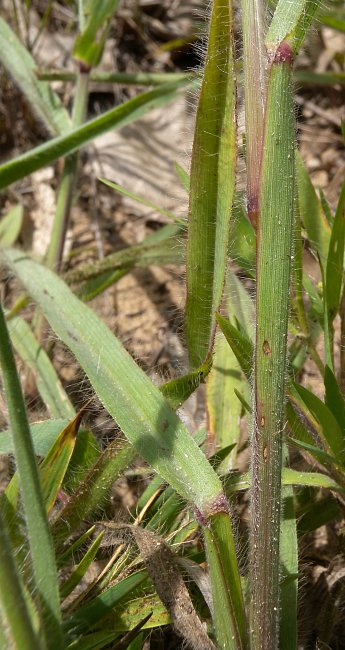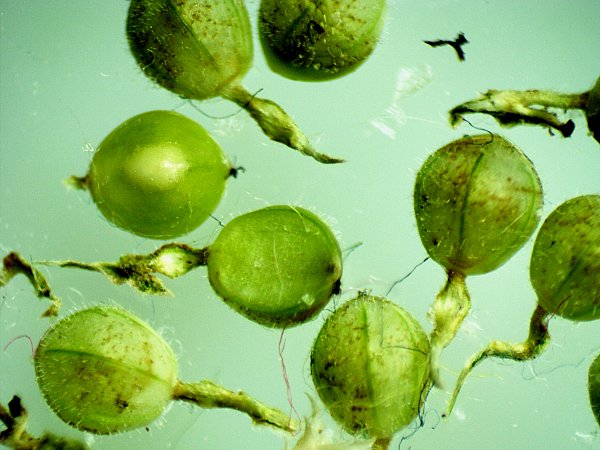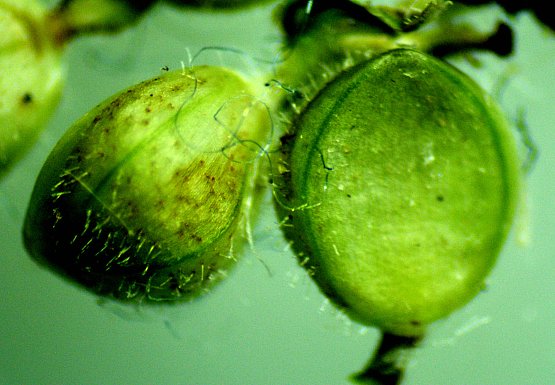Bush's Bead
Grass
Paspalum bushii
Grass family (Poaceae)
Paspalum bushii
Grass family (Poaceae)
Description:
This perennial grass forms a loose tuft of leafy culms up to 2¼' tall;
the leafy culms are erect, ascending, or sprawling. One or more of
these culms develop from the base of plant, otherwise they are
unbranched. Individual culms are light green, terete or slightly
compressed, and glabrous to slightly pubescent. Alternate leaves occur
along the entire length of each culm. The leaf blades are up to 15 mm.
across and 10" long; these blades taper very little at the base and
they are widely spreading to ascending. In addition, the leaf blades
are often keeled or hull-shaped along their length. The upper and lower
leaf blade surfaces are light olive-green (sometimes purplish at the
base), minutely and densely pubescent, and long-hairy. The long hairs
of the leaf blades are especially common along their margins. The
texture of the leaf blades is soft and velvety.

The leaf sheaths are light olive-green or purplish olive-green, minutely and densely pubescent, and long-hairy. The long hairs of the leaf sheaths are especially common along their margins. The leaf sheaths wrap around the culms rather loosely; they are vertically veined. The nodes along the culms are swollen, purplish, and finely pubescent. Each fertile culm terminates in an inflorescence consisting of 2–3 spike-like racemes of florets. These spike-like racemes are usually ascending and sometimes slightly arching. The rachis (central stalk) of each raceme is about 1 mm. thick, 2½–5½" long, light olive-green, grooved, and slightly zigzag along its length. Along the length of each rachis, there occurs pairs of floral spikelets that are closely spaced together. The peduncle (basal stalklet) and pedicels to which each pair of spikelets are attached are about 1 mm. long.

Each spikelet consists of 1 glume, 1 sterile lemma, 1 fertile lemma, 1 palea, three stamens with white anthers (later turning brown), and a pair of purplish feathery styles. The glume and lemmas are about 2 mm. long and the same or slightly less across. The fertile lemma and palea are hardened. The outer side (dorsal surface) of each spikelet is flat and either hairless or finely short-hairy, while the inner side (ventral surface) of each spikelet is very convex and finely short-hairy (requires 10x magnification to see). On the convex side of each spikelet there are 3 vertical veins; on immature spikelets, these veins are dark green on a light green background. The blooming period occurs from mid-summer to early autumn, although the florets of individual racemes remain in bloom for only 1–2 weeks. Cross-pollination occurs by wind. Afterwards, the spikelets become mature, changing to yellow or brown in color. Each spikelet (if it remains fertile) produces a single grain that is slightly smaller in size than the fertile lemma and palea. The root system is primarily fibrous, although short rhizomes are sometimes produced. The latter can produce clonal offsets.

Cultivation: The preference is full or partial sun, mesic to dry conditions, and sandy soil. This grass colonizes open sandy ground where there is reduced competition from other ground vegetation.
Range & Habitat: Bush's Bead Grass (Paspalum bushii) is native to the western half of Illinois, where it is considered rare, and state-listed as endangered (see Distribution Map). Illinois lies along the northeastern range-limit of this grass. In Illinois, habitats include upland sandy savannas, openings in upland sandy woodlands, upland sand prairies, and sandstone glades. It sometimes occurs in more disturbed habitats, such as sandy roadsides and sandy fallow fields. In the wooded habitats where this grass occurs, the dominant canopy trees are often Black Oak (Quercus velutina) or Blackjack Oak (Quercus marilandica).

Faunal Associations: Many insects feed on the foliage and other parts of bead grasses (Paspalum spp.). Examples of such insects include mealybugs, grasshoppers, the larvae of skippers, and the larvae of moths. The Insect Table shows a list of these insect species. The seeds of bead grasses are eaten by various songbirds and upland gamebirds, including the Mourning Dove, Slate-colored Junco, Vesper Sparrow, Brown-headed Cowbird, Bobwhite Quail, Wild Turkey, and Greater Prairie Chicken. The American Bison and Cottontail Rabbit sometimes feed on the foliage of bead grasses (Martin et al., 1951/1961; Yeatter, 1943).
Photographic Location: An opening in a sandy woodland at the Sand Prairie and Scrub Oak Nature Preserve in Mason County, Illinois.

Comments: The taxonomic history of this grass is rather unstable. Mohlenbrock (2016, 2002) refers to this grass as Paspalum bushii, while other authorities currently refer to this grass as Paspalum setaceum stramineum (also Paspalum ciliatifolium stramineum, but this latter scientific name is considered obsolete). The grass Paspalum setaceum is regarded as a polymorphic species that has been divided into several varieties by some authorities. While the majority of bead grasses (Paspalum spp.) prefer relatively moist low-lying areas, Bush's Bead Grass (Paspalum bushii) is an upland grass that prefers sandy areas. In general, this grass can be distinguished from other bead grasses in Illinois by the small size of its spikelets (about 2 mm. in length and almost as wide), the presence of short fine hairs on the convex side of its spikelets, the presence of both very short fine pubescence and long white hairs on its foliage, and the soft velvety texture of its leaf blades. A hand lens with 10x magnification may be required in order to see some of these distinctive characteristics. Another common name that can be used for this grass is Yellow Bead Grass.

The leaf sheaths are light olive-green or purplish olive-green, minutely and densely pubescent, and long-hairy. The long hairs of the leaf sheaths are especially common along their margins. The leaf sheaths wrap around the culms rather loosely; they are vertically veined. The nodes along the culms are swollen, purplish, and finely pubescent. Each fertile culm terminates in an inflorescence consisting of 2–3 spike-like racemes of florets. These spike-like racemes are usually ascending and sometimes slightly arching. The rachis (central stalk) of each raceme is about 1 mm. thick, 2½–5½" long, light olive-green, grooved, and slightly zigzag along its length. Along the length of each rachis, there occurs pairs of floral spikelets that are closely spaced together. The peduncle (basal stalklet) and pedicels to which each pair of spikelets are attached are about 1 mm. long.

Each spikelet consists of 1 glume, 1 sterile lemma, 1 fertile lemma, 1 palea, three stamens with white anthers (later turning brown), and a pair of purplish feathery styles. The glume and lemmas are about 2 mm. long and the same or slightly less across. The fertile lemma and palea are hardened. The outer side (dorsal surface) of each spikelet is flat and either hairless or finely short-hairy, while the inner side (ventral surface) of each spikelet is very convex and finely short-hairy (requires 10x magnification to see). On the convex side of each spikelet there are 3 vertical veins; on immature spikelets, these veins are dark green on a light green background. The blooming period occurs from mid-summer to early autumn, although the florets of individual racemes remain in bloom for only 1–2 weeks. Cross-pollination occurs by wind. Afterwards, the spikelets become mature, changing to yellow or brown in color. Each spikelet (if it remains fertile) produces a single grain that is slightly smaller in size than the fertile lemma and palea. The root system is primarily fibrous, although short rhizomes are sometimes produced. The latter can produce clonal offsets.

Cultivation: The preference is full or partial sun, mesic to dry conditions, and sandy soil. This grass colonizes open sandy ground where there is reduced competition from other ground vegetation.
Range & Habitat: Bush's Bead Grass (Paspalum bushii) is native to the western half of Illinois, where it is considered rare, and state-listed as endangered (see Distribution Map). Illinois lies along the northeastern range-limit of this grass. In Illinois, habitats include upland sandy savannas, openings in upland sandy woodlands, upland sand prairies, and sandstone glades. It sometimes occurs in more disturbed habitats, such as sandy roadsides and sandy fallow fields. In the wooded habitats where this grass occurs, the dominant canopy trees are often Black Oak (Quercus velutina) or Blackjack Oak (Quercus marilandica).

Faunal Associations: Many insects feed on the foliage and other parts of bead grasses (Paspalum spp.). Examples of such insects include mealybugs, grasshoppers, the larvae of skippers, and the larvae of moths. The Insect Table shows a list of these insect species. The seeds of bead grasses are eaten by various songbirds and upland gamebirds, including the Mourning Dove, Slate-colored Junco, Vesper Sparrow, Brown-headed Cowbird, Bobwhite Quail, Wild Turkey, and Greater Prairie Chicken. The American Bison and Cottontail Rabbit sometimes feed on the foliage of bead grasses (Martin et al., 1951/1961; Yeatter, 1943).
Photographic Location: An opening in a sandy woodland at the Sand Prairie and Scrub Oak Nature Preserve in Mason County, Illinois.

Comments: The taxonomic history of this grass is rather unstable. Mohlenbrock (2016, 2002) refers to this grass as Paspalum bushii, while other authorities currently refer to this grass as Paspalum setaceum stramineum (also Paspalum ciliatifolium stramineum, but this latter scientific name is considered obsolete). The grass Paspalum setaceum is regarded as a polymorphic species that has been divided into several varieties by some authorities. While the majority of bead grasses (Paspalum spp.) prefer relatively moist low-lying areas, Bush's Bead Grass (Paspalum bushii) is an upland grass that prefers sandy areas. In general, this grass can be distinguished from other bead grasses in Illinois by the small size of its spikelets (about 2 mm. in length and almost as wide), the presence of short fine hairs on the convex side of its spikelets, the presence of both very short fine pubescence and long white hairs on its foliage, and the soft velvety texture of its leaf blades. A hand lens with 10x magnification may be required in order to see some of these distinctive characteristics. Another common name that can be used for this grass is Yellow Bead Grass.